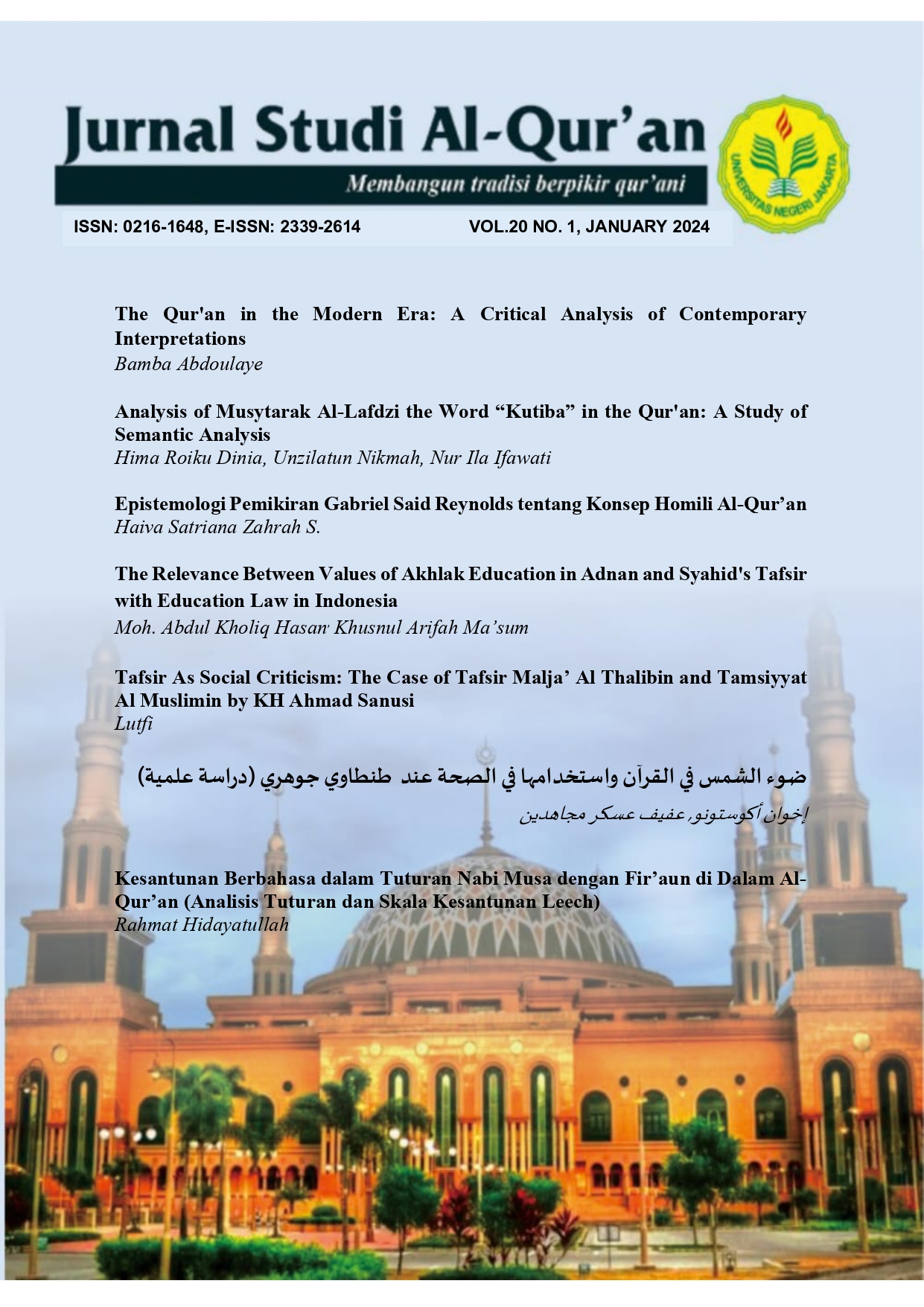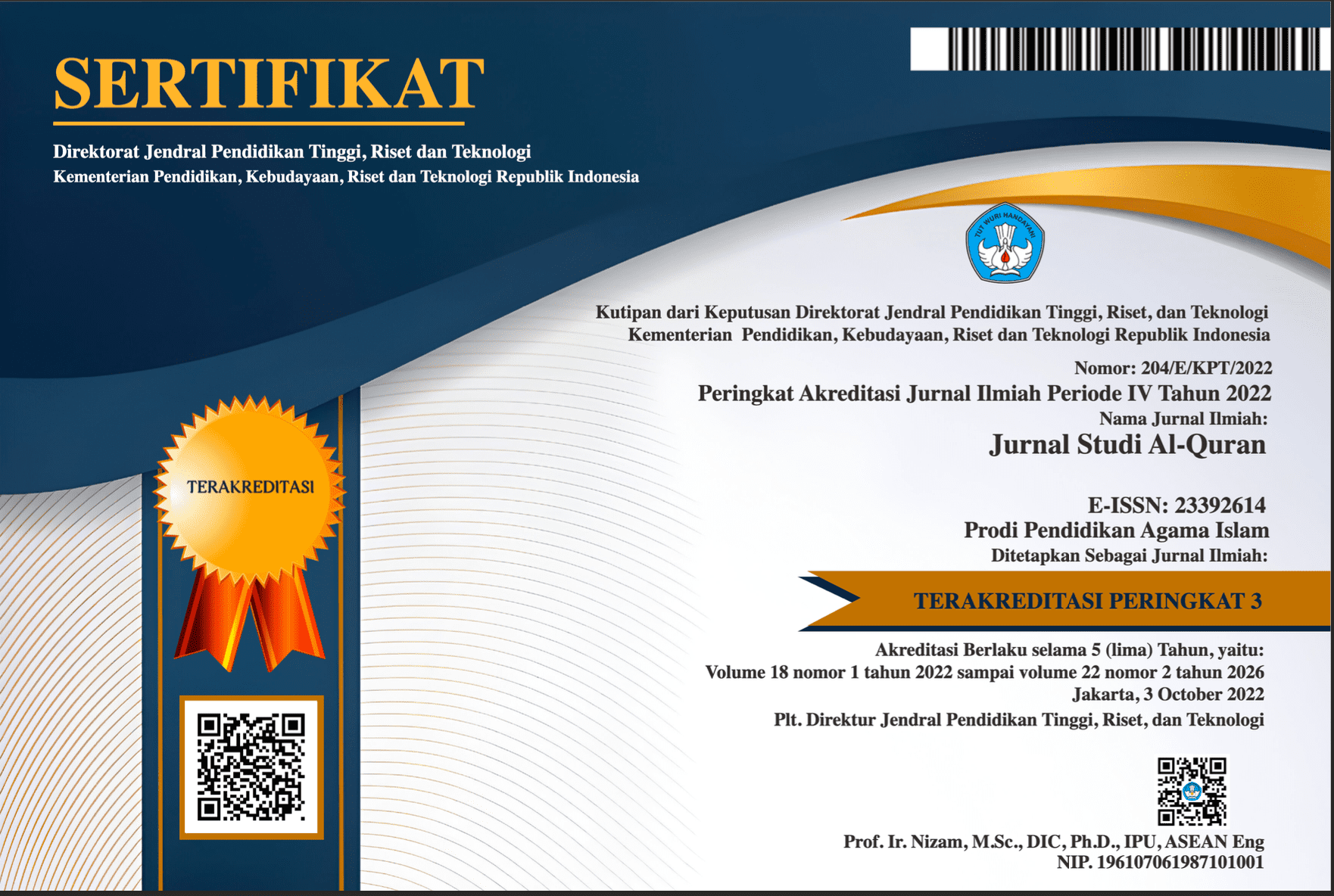Epistemology of Gabriel Said Reynolds' Thoughts on the Concept of the Al-Qur'an Homily
DOI:
https://doi.org/10.21009/JSQ.20.1.03Keywords:
Homili, Epsitemolog, ReynoldsAbstract
This study examines the epistemology of Reynolds' thought, which initiated the concept of discourse to read (understand) the Qur'an. Reynolds made a new formulation by seeing the pattern of connectedness between texts and trying to break the argument that considered the Qur'an an imitation text from the Jewish and Christian traditions. This study aims to describe the discourse initiated by Reynolds, review the epistemology of his thoughts, and explain the implications of this concept. This research is a qualitative study in the form of library research using the Qur'an and its biblical subtext as the primary data source and a theoretical hermeneutic approach as an analytical tool in reviewing the book. The results of this study indicate that the Qur'an with pre-Quranic texts has a different literary genre; on the other hand, the Qur'an has a homily nature in developing its religious values. The concept of this homily carries methodological consequences for reading or interpreting the Qur'an with previous texts, namely the apocryphal Bible and Jewish and Christian exegetical works. Methodologically, Reynolds used alliterative theory and a literary approach. The concept of discourse has implications for assessing the Bible so that they are mindlessly suspicious of it, and using the Bible as a source or reference can be an alternative to understanding the Qur'an.
References
Abdullah, A. Bin, & Ismail, K. N. I. K. (2008). Disclosure of Voluntary Accounting Ratios by Malaysian Listed Companies. Journal of Financial Reporting and Accounting, 6(1), 1–20. https://doi.org/10.1108/19852510880000632
Aisyah, C. N., & Sudarno. (2014). Pengaruh Struktur Kepemilikan dan R&D Terhadap Luas Pengungkapan Modal Intelektual. Diponegoro Journal of Accounting, 3(2), 154–168.
Albertini, E., & Berger-Remy, F. (2019). Intellectual Capital and Financial Performance: A Meta-Analysis and Research Agenda. Management (France), 22(2), 216–249. https://doi.org/10.3917/mana.222.0216
An, Y., Davey, H., Eggleton, I. R. C., & Wang, Z. (2015). Intellectual Capital Disclosure and The Information Gap: Evidence from China. Advances in Accounting, 31(2), 179–187. https://doi.org/10.1016/j.adiac.2015.09.001
Astuti, N. M. A., & Wirama, D. G. (2016). Pengaruh Ukuran Perusahaan, Tipe Industry dan Intensitas Research and Development pada Pengungkapan Modal Intelektual. E-Jurnal Akuntansi Universitas Udayana, 15(1), 522–548.
Astuti, R. N., Fachrurrozie, Amal, M. I., & Zahra, S. F. (2020). Does Audit Committee Quality Mediate Determinants of Intellectual Capital Disclosure? Journal of Asian Finance, Economics and Business, 7(7), 199–208. https://doi.org/10.13106/jafeb.2020.vol7.no7.199
Azis, S. N., Pagalung, G., & Habbe, A. H. (2019). Pengungkapan Modal Intelektual dan Keuangan dalam Kapitalisasi Pasar dengan Siklus Hidup Industri Sebagai Pemoderasi) (Intellectual Capital Disclosure and Financial Disclosure in Market Capitalization with Industry Lifecycle As Moderating Variable). Jurnal Akuntansi dan Keuangan Indonesia,16(1),61–82.
Barokah, L., & Fachrurrozie. (2019). Profitability Mediates The Effect of Managerial Ownership, Company Size, and Leverage on The Disclosure of Intellectual Capital. Accounting Analysis Journal, 8(1), 1–8. https://doi.org/10.15294/aaj.v8i1.27860
Bohalima, E. R., Zai, A. N., & Sitepu, W. R. B. (2021). Analisis Faktor-faktor yang Memengaruhi Intellectual Capital Disclosure pada Perusahaan Jasa yang Terdaftar di Bursa Efek Indonesia Periode Tahun 2017-2019. Akuntansi
Dewantara, 5(1), 33–49. https://doi.org/10.26460/ad.v5i1.9260
Brüggen, A., Vergauwen, P., & Dao, M. (2009). Determinants of Intellectual Capital Disclosure: Evidence from Australia. Management Decision, 47(2), 233–245. https://doi.org/10.1108/00251740910938894
Chen, M. (2019). Pengaruh Ukuran Perusahaan Terhadap Intellectual Capital Disclosure pada Perusahaan Manufaktur yang Terdaftar di Bursa Efek Indonesia. Jurnal Keuangan dan Bisnis, 17(2), 38. https://doi.org/10.32524/jkb.v17i2.580
Cheng, M. Y., Lin, J. Y., Hsiao, T. Y., & Lin, T. W. (2010). Invested Resource, Competitive Intellectual Capital, and Corporate Performance. Journal of Intellectual Capital, 11(4), 433–450. https://doi.org/10.1108/14691931011085623
Delvia, Y., & Alexander, N. (2018). The Effect of Size, Firm Age, Growth, Audit Reputation, Ownership and Financial Ratio on Intellectual Capital Disclosure. Jurnal Bisnis dan Akuntansi, 20(1),69–76.
Dumay, J. (2016). A Critical Reflection on The Future of Intellectual Capital: from Reporting to Disclosure. Journal of Intellectual Capital, 17(1), 168–184. https://doi.org/10.1108/jic-08-2015-0072
Fakhroni, Z., & Irwansyah. (2017). Intellectual Capital dan Market Value: Studi Perusahaan High-Ic Intensive di Bursa Efek Indonesia. Jurnal Riset Akuntansi dan Keuangan, 5(3),1575–1588. https://doi.org/10.17509/jrak.v5i3.9232329
Ghozali, I., & Ratmono, D. (2017). Analisis Multivariant dan Ekonometrika: Teori, Konsep dan Aplikasi dengan Eviews 10 (2nd ed.). Badan Penerbit Universita Diponogoro.
Gkotsis, P., Pugliese, E., & Vezzani, A. (2018). A Technology-based Classification of Firms: Can We Learn Something Looking Beyond Industry Classifications? Entropy, 20(11), 887. https://doi.org/10.3390/e20110887
Ishaq, Dewi, R. R., & Wijayanti, A. (2020). The Effect of Company Size, Industry Type and Research and Development Intensity on Intellectual Capital Disclosure. Journal of Economics, Business, and Government Challenges, 3(2), 87–94. https://doi.org/10.33005/ebgc.v3i2.126
Isnalita, N. I. D. N., & Romadhon, F. (2018). The Effect of Company Characteristics and Corporate Governance on The Practices of Intellectual Capital Disclosure. International Research Journal of Business Studies, 11(3), 217–230. https://doi.org/10.21632/irjbs.11.3.217-230
Jones, D. A. (2007). Voluntary Disclosure in R&D-intensive Industries. Contemporary Accounting Research, 24(2), 489–522. https://doi.org/10.1506/g3m3-2532-514h-1517
Khosidah, N., & Wahyudin, A. (2019). The Roles of Profitability in Moderating The Effects of Managerial Ownership Leverage, and Firm Size Toward Intellectual Capital Disclosure. Accounting Analysis Journal, 8(2), 74–80. https://doi.org/10.15294/aaj.v8i2.33775
Kianto, A., Andreeva, T., & Pavlov, Y. (2013). The Impact of Intellectual Capital Management on Company Competitiveness and Financial Performance. Knowledge Management Research and Practice, 11(2), 112–122. https://doi.org/10.1057/kmrp.2013.9
Kozlenkova, I. V., Samaha, S. A., & Palmatier, R. W. (2014). Resource-based Theory in Marketing. Journal of The Academy of Marketing Science, 42(1), 1–21. https://doi.org/10.1007/s11747-013-0336-7
Lentjushenkova, O., Zarina, V., & Titko, J. (2019). Disclosure of Intellectual Capital in Financial Reports: Case of Latvia. Oeconomia Copernicana,10(2), 341–357. https://doi.org/10.24136/oc.2019.017
Madhani, P. M. (2012). Intangible Assets: Value Drivers for Competitive Advantage. in G. N. Gregoriou & N. Finch (Eds.), Best Practices in Management Accounting (Vol. 30). Palgrave Macmillan. https://doi.org/10.1057/9780230361553
Mkumbuzi, W. P. (2015). Investment in Employees and Research and Development and The Signalling of Intellectual Capital by UK Listed Companies. Asian Social Science, 11(21), 148–161. https://doi.org/10.5539/ass.v11n21p148
Mouritsen, J., Nikolajbukh, P., & Marr, B. (2004). Reporting On Intellectual Capital: Why, What and How? Measuring Business Excellence, 8(1), 46–54. https://doi.org/10.1108/13683040410524739
Nadeem, M., Dumay, J., &Massaro, M. (2019). If You Can Measure It, You Can Manage It: A Case of Intellectual Capital. Australian Accounting Review, 29(2), 395–407. https://doi.org/10.1111/auar.12227
Naimah, Z., &Mukti, N. A. (2019). The Influence of Audit Committee’s and Company’s Characteristic on Intellectual Capital Disclosure. Asian Journal of Accounting Research, 4(2), 170–180. https://doi.org/10.1108/ajar-05-2019-0036
Nguyen, A. H., Pham, H. T., & Nguyen, H. T. (2020). Impact of Working Capital Management on Firm’s Profitability: Empirical Evidence From Vietnam. Journal of Asian Finance, Economics and Business, 7(3), 115–125. https://doi.org/10.13106/jafeb.2020.vol7.no3.115
Obeidat, B. Y., Tarhini, A., Masadeh, R., & Aqqad, N. O. (2017). The Impact of Intellectual Capital on Innovation Via The Mediating Role of Knowledge Management: A Structural Equation Modelling Approach. International Journal of Knowledge Management Studies, 8(3–4), 273–298. https://doi.org/10.1504/ijkms.2017.087071
Ousama, A. A., Fatima, A., & Hafiz‐Majdi, A. R. (2012). Determinants of Intellectual Capital Reporting: Evidence from Annual Reports of Malaysian Listed Companies. Journal of Accounting in Emerging Economies, 2(2), 119–139. https://doi.org/10.1108/20421161211229808
Padgett, R. C., & Galan, J. I. (2010). The Effect of R&D Intensity on Corporate Social Responsibility. Journal of Business Ethics, 93(3), 407–418. https://doi.org/10.1007/s10551-009-0230-x
Park, J. H., & Shim, H. (2019). R&D Intensity and Regulation Fair Disclosure. Journal of Asian Finance, Economics and Business,6(1),281–288. https://doi.org/10.13106/jafeb.2019.vol6.no1.281
Pratama, B. C., Wibowo, H., & Innayah, M. N. (2019). Intellectual Capital and Firm Performance in ASEAN:The Role of Research and Development. Journal of Accounting and Investment, 20(3). https://doi.org/10.18196/jai.2003126
Rahman, M. M., Sobhan, R., & Islam, M. S. (2019). Intellectual Capital Disclosure and Its Determinants: Empirical Evidence from Listed Pharmaceutical and Chemical Industry of Bangladesh. Journal of Business Economics and Environmental Studies, 9(2), 35–46. https://doi.org/10.13106/jbees.2019.vol9.no2.35
Saputro, Y. A., & Syafruddin, M. (2017). Karakteristik Perusahaan dan Pengungkapan Modal Intelektual: Perusahaan-Perusahaan di Indonesia Tahun 2015. Diponegoro Journal of Accounting, 6(4), 171–185.
Sariningsih, W., & Saputro, F. E. N. (2020). Firm Size, Profitabilitas, Leverage, Jenis Perusahaan Audit, Jenis Industri, Penelitian dan Pengembangan Sebagai Determinan Pengungkapan Modal Intelektual (ICD). Jurnal Akuntansi, Keuangan dan Bisnis, 6(2), 104–116.
Sudibyo, A. A., & Basuki, B. (2017). Intellectual Capital Disclosure Determinants and Its Effects on The Market Capitalization: Evidence from Indonesian Listed Companies. Shsweb of Conferences, 34, 07001. https://doi.org/10.1051/Shsconf/20173407001
Sugandi, H., & Handojo, I. (2019). The Determinants of Intellectual Capital Disclosure. Jurnal Bisnis dan Akuntansi, 20(2), 93–100. https://doi.org/10.34208/jba.v20i2.413
Supradnya, I. N. T., & Ulupui, I. G. K. A. (2016). Pengaruh Jenis Industri, Kepemilikan Manajerial, Kepemilikan Institusional, dan Kepemilikan Asing Terhadap Kinerja Modal Intelektual. E-Jurnal Ekonomi dan Bisnis Universitas Udayana, 5(5),1385–1410.
Susanto, Y. K., Pradipta, A., & Handojo, I. (2019). Determinant Of Intellectual Capital Disclosure. International Journal of Business, Economics And Law, 20(5), 83–89.
Suyono, N. A. (2019). Analisis Pengaruh Ownership Structure, Ukuran Perusahaan dan Jenis Industri Terhadap Pengungkapan Modal Intelektual. Journal of Economic, Management, Accounting and Technology, 2(2), 156–168. https://doi.org/10.32500/jematech.v2i2.729
Sveiby, K. (2010). Methods for Measuring Intangible Assets. https://www.sveiby.com/files/pdf/intangiblemethods.pdf
Ulum, I. (2015). Intellectual Capital Disclosure: An Analysis with Fourway Numerical Coding System. Jurnal Akuntansi dan Auditing Indonesia, 19(1), 39–50.
Ulum, I., Salim, T. F. A., & Kurniawati, E. T. (2016). Pengaruh Corporate Governance Terhadap Praktik Pengungkapan Modal Intelektual di Indonesia. Jurnal Dinamika Akuntansi dan Bisnis, 3(1), 37–45. https://doi.org/10.24815/jdab.v3i1.4395
Wahyuni, M. A., & Rasmini, N. K. (2016). Pengaruh Mekanisme Corporate Governance Pada Pengungkapan Modal Intelektual (Studi Empiris Pada Perusahaan Manufaktur Yang Terdaftar Di Bursa Efek Indonesia). Buletin Studi Ekonomi, 21(1), 48–59.
Whiting, R. H., & Woodcock, J. (2011). Firm Characteristics and Intellectual Capital Disclosure by Australian Companies. Journal of Human Resource Costing & Accounting, 15(2), 102–126. https://doi.org/10.1108/14013381111157337
Widiatmoko, J., &Indarti, M. G. K. (2018). Karakteristik Perusahaan, Tipe Auditor dan Konsentrasi Kepemilikan Saham Terhadap Pengungkapan Modal Intelektual. Jurnal Bisnis dan Ekonomi, 25(2),160–172.
Yau, F. S., Chun, L. S., & Balaraman, R. (2009). Intellectual Capital Reporting and Corporate Characteristics of Public‐Listed Companies in Malaysia. Journal of Financial Reporting and Accounting, 7(1), 17–35. https://doi.org/10.1108/19852510980000639
Downloads
Published
How to Cite
Issue
Section
License
Authors who publish with this Journal agree to the following terms:
- Author retain copyright and grant the journal right of first publication with the work simultaneously licensed under a creative commons attribution licensethat allow others to share the work within an acknowledgement of the work’s authorship and initial publication of this journal.
- Authors are able to enter into separate, additional contractual arrangementfor the non-exclusive distribution of the journal’s published version of the work (e.g. acknowledgement of its initial publication in this journal).
- Authors are permitted and encouraged to post their work online(e.g. in institutional repositories or on their websites) prior to and during the submission process, as it can lead to productive exchanges, as well as earlier and greater citation of published works.
Users/public use of this website will be licensed to CC BY










